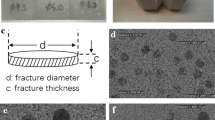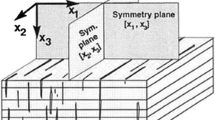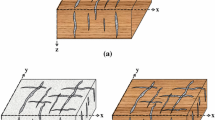Abstract
Seismic anisotropy can help to extract azimuthal information for predicting crack alignment, but the accurate evaluation of cracked reservoir requires knowledge of degree of crack development, which is achieved through determining the crack density from seismic or VSP data. In this research we study the dependence of seismic anisotropy on crack density, using synthetic rocks with controlled crack geometries. A set of four synthetic rocks containing different crack densities is used in laboratory measurements. The crack thickness is 0.06 mm and the crack diameter is 3 mm in all the cracked rocks, while the crack densities are 0.00, 0.0243, 0.0486, and 0.0729. P and S wave velocities are measured by an ultrasonic investigation system at 0.5 MHz while the rocks are saturated with water. The measurements show the impact of crack density on the P and S wave velocities. Our results are compared to the theoretical prediction of Chapman (J App Geophys 54:191–202, 2003) and Hudson (Geophys J R Astron Soc 64:133–150, 1981). The comparison shows that measured velocities and theoretical results are in good quantitative agreement in all three cracked rocks, although Chapman’s model fits the experimental results better. The measured anisotropy of the P and S wave in the four synthetic rocks shows that seismic anisotropy is directly proportional to increasing crack density, as predicted by several theoretical models. The laboratory measurements indicate that it would be effective to use seismic anisotropy to determine the crack density and estimate the intensity of crack density in seismology and seismic exploration.













Similar content being viewed by others
References
Ass’ Ad, J. M., Tatham, R. H., & McDonald, J. A. (1992). A physical model study of microcrack-induced anisotropy. Geophysics, 57, 1562–1570.
Backus, G. E. (1962). Long-wave elastic anisotropy produced by horizontal layering. Journal of Geophysical Research, 67, 4427–4440.
Barbier, M., Hamon, Y., Callot, J.-P., Floquet, M., & Daniel, J.-M. (2012). Sedimentary and diagenetic controls on the multiscale fracturing pattern of a carbonate reservoir: The Madison Formation (Sheep Mountain, Wyoming, USA). Marine and Petroleum Geology, 29, 50–67.
Boness, N. L., & Zoback, M. D. (2004). Stress-induced seismic velocity anisotropy and physical properties in the SAFOD Pilot Hole in Parkfield, CA. Geophysical Research Letters, 31, L15S17.
Cao, J., He, Z., Huang, D., & Li, Q. (2003). Seismic responses of fractured reservoirs by physical modeling. Progress in Exploration Geophysics (in Chinese), 26, 88–93.
Chapman, M. (2003). Frequency-dependent anisotropy due to meso-scale fractures in the presence of equant porosity. Geophysical Prospecting, 51, 369–379.
Chapman, M., Maultzsch, S., Liu, E., & Li, X. Y. (2003). The effect of fluid saturation in an anisotropic multi-scale equant porosity model. Journal of Applied Geophysics, 54, 191–202.
Chapman, M., Zatsepin, S. V., & Crampin, S. (2002). Derivation of a microstructural poroelastic model. Geophysical Journal International, 151, 427–451.
Crampin, S. (1984). Effective anisotropic elastic constants for wave propagation through cracked solids. Geophysical Journal of the Royal Astronomical Society, 76, 135–145.
De Keijzer, M., Hillgartner, H., Al Dhahab, S., & Rawnsley, K. (2007). A surface-subsurface study of reservoir-scale fracture heterogeneities in Cretaceous carbonates, North Oman. Geological Society, London, Special Publications, 270, 227–244.
Ding, P., Di, B., Wang, D., Wei, J., & Li, X. (2014). P and S wave anisotropy in fractured media: Experimental research using synthetic samples. Journal of Applied Geophysics, 109, 1–6.
Ding, P., Di, B., Wei, J., Di, X., Deng, Y., & Li, X. (2013). Laboratory measurements of P- and S-wave anisotropy in synthetic sandstones with controlled fracture density. SEG Technical Program Expanded Abstracts, 2013, 2979–2983.
Eshelby, J. D. (1957). The determination of the elastic field of an ellipsoidal inclusion, and related problems. Proceedings of the Royal Society of London. Series A. Mathematical and Physical Sciences, 241, 376–396.
Far, M. E., de Figueiredo, J. J. S., Stewart, R. R., Castagna, J. P., Han, D.-H., & Dyaur, N. (2014). Measurements of seismic anisotropy and fracture compliances in synthetic fractured media. Geophysical Journal International, 197, 1845–1857.
Grechka, V., & Kachanov, M. (2006). Effective elasticity of fractured rocks: A snapshot of the work in progress. Geophysics, 71, W45–W58.
Guéguen, Y., & Sarout, J. (2009). Crack-induced anisotropy in crustal rocks: Predicted dry and fluid-saturated Thomsen’s parameters. Physics of the Earth and Planetary Interiors, 172, 116–124.
Guéguen, Y., & Sarout, J. (2011). Characteristics of anisotropy and dispersion in cracked medium. Tectonophysics, 503, 165–172.
Hall, S. A., Kendall, J. M., Maddock, J., & Fisher, Q. (2008). Crack density tensor inversion for analysis of changes in rock frame architecture. Geophysical Journal International, 173, 577–592.
He, Z., Li, Y., Zhang, F., & Huang, D. (2001). Different effects of vertically oriented fracture system on seismic velocities and wave apmlitude-Analysis of laboratory experimental results. Computing Techniques for Geophysical and Geochemical Exploration, 23, 1–5.
Hudson, J. A. (1980). Overall properties of a cracked solid. Mathematical Proceedings of the Cambridge Philosophical Society, 88, 371–384.
Hudson, J. A. (1981). Wave speeds and attenuation of elastic waves in material containing cracks. Geophysical Journal of the Royal Astronomical Society, 64, 133–150.
Kuwahara, Y., Ito, H., & Kiguchi, T. (1991). Comparison between natural fractures and fracture parameters derived from VSP. Geophysical Journal International, 107, 475–483.
Liu, E., Hudson, J. A., & Pointer, T. (2000). Equivalent medium representation of fractured rock. Journal of Geophysical Research, A: Space Physics, 105, 2981–3000.
Lou, M., Shalev, E., & Malin, P. E. (1997). Shear-wave splitting and fracture alignments at the Northwest Geysers, California. Geophysical Research Letters, 24, 1895–1898.
Mallick, S., & Frazer, L. N. (1991). Reflection/transmission coefficients and azimuthal anisotropy in marine seismic studies. Geophysical Journal International, 105, 241–252.
Rathore, J. S., Fjaer, E., Holt, R. M., & Renlie, L. (1995). P- and S-wave anisotropy of a synthetic sandstone with controlled crack geometry. Geophysical Prospecting, 43, 711–728.
Sarout, J., & Guéguen, Y. (2008a). Anisotropy of elastic wave velocities in deformed shales: Part 1—experimental results. Geophysics, 73, D75–D89.
Sarout, J., & Guéguen, Y. (2008b). Anisotropy of elastic wave velocities in deformed shales: Part 2—modeling results. Geophysics, 73, D91–D103.
Sarout, J., Molez, L., Guéguen, Y., & Hoteit, N. (2007). Shale dynamic properties and anisotropy under triaxial loading: Experimental and theoretical investigations. Physics and Chemistry of the Earth, Parts A/B/C, 32, 896–906.
Schoenberg, M., & Sayers, C. M. (1995). Seismic anisotropy of fractured rock. Geophysics, 60, 204–211.
Stephenson, B. J., Koopman, A., Hillgartner, H., McQuillan, H., Bourne, S., Noad, J. J., et al. (2007). Structural and stratigraphic controls on fold-related fracturing in the Zagros Mountains, Iran: Implications for reservoir development. Geological Society, London, Special Publications, 270, 1–21.
Thomsen, L. (1986). Weak elastic anisotropy. Geophysics, 51, 1954–1966.
Thomsen, L. (1995). Elastic anisotropy due to aligned cracks in porous rock. Geophysical Prospecting, 43, 805–829.
Tillotson, P., Chapman, M., Best, A. I., Sothcott, J., McCann, C., Shangxu, W., et al. (2011). Observations of fluid-dependent shear-wave splitting in synthetic porous rocks with aligned penny-shaped fractures‡. Geophysical Prospecting, 59, 111–119.
Tillotson, P., Sothcott, J., Best, A. I., Chapman, M., & Li, X.-Y. (2012). Experimental verification of the fracture density and shear-wave splitting relationship using synthetic silica cemented sandstones with a controlled fracture geometry. Geophysical Prospecting, 60, 516–525.
Valcke, S. L. A., Casey, M., Lloyd, G. E., Kendall, J.-M., & Fisher, Q. J. (2006). Lattice preferred orientation and seismic anisotropy in sedimentary rocks. Geophysical Journal International, 166, 652–666.
Varghese, A. V., Chapman, M., Li, X. Y., & Wang, Y. (2009). Observations of azimuthal variation of attenuation anisotropy in 3D VSPs. SEG Technical Program Expanded Abstracts, 2009, 4174–4178.
Vernik, L., & Nur, A. (1992). Ultrasonic velocity and anisotropy of hydrocarbon source rocks. Geophysics, 57, 727–735.
Wang, Y. (2011). Seismic anisotropy estimated from P-wave arrival times in crosshole measurements. Geophysical Journal International, 184, 1311–1316.
Wei, J.-X., Di, B.-R., & Ding, P.-B. (2013). Effect of crack aperture on P-wave velocity and dispersion. Applied Geophysics, 10, 125–133.
Zatsepin, S. V., & Crampin, S. (1997). Modelling the compliance of crustal rock—I. Response of shear-wave splitting to differential stress. Geophysical Journal International, 129, 477–494.
Acknowledgements
We thank Mark Chapman from the University of Edinburgh who provided sustained support during the entire research. Special thanks to David Booth from British Geological Survey for proofreading. This research is supported by the National Natural Science Fund Projects (U1663203) and the National Natural Science Fund Projects (41474112).
Author information
Authors and Affiliations
Corresponding author
Appendix
Appendix
In the case of a material containing aligned or randomly orientated cracks, the overall elastic properties derived by Hudson contain the second order in the concentration. Both the single scattering formulae, which are correct to the first order in crack density \( \varepsilon_{\text{c}} \), and crack–crack interactions, which are correct to the second order in crack density, are accounted. The model considered a plane wave propagating through the medium with cracks, but the pores in the background matrix are neglected.
The stiffness tensor of the medium contain cracks in the Hudson model is given as
in which \( C_{ij}^{{}} \) is the total stiffness tensor, \( C_{ij}^{0} \) is the background, \( C_{ij}^{1} \), and \( C_{ij}^{2} \) are the first- and second-order effects of the cracks:
in which \( q = 15\left( {\frac{\lambda }{\mu }} \right)^{2} + 28\left( {\frac{\lambda }{\mu }} \right) + 28 \). In the case of water saturation,
The Chapman’s model considers frequency-dependent seismic anisotropy in fractured rocks through knowledge of rock porosity, permeability, fracture density, and pore fluid properties. The model is based on fluid interactions at two scales: randomly aligned microcracks and aligned mesoscale fractures.
The stiffness tensor given by Chapman (2003) is
where \( C_{ijkl}^{0} \) is the isotropic background matrix of porous rock, \( C_{ijkl}^{1} \), \( C_{ijkl}^{2} \), and \( C_{ijkl}^{3} \) are the contributions from pores, grain size cracks, and meso-scale fractures, respectively. \( \phi_{\text{p}} \) is the porosity, \( \varepsilon_{\text{c}} \) is the crack density, and \( \varepsilon_{\text{f}} \) is the fracture density.
where \( N_{\text{c}} \) and \( N_{\text{f}} \) are the number of cracks and fractures in volume V, \( a_{\text{c}} \) and \( a_{\text{f}} \) are the radium of cracks and fractures, respectively. The model parameters are the functions of the elastic tensor (isotropic matrix \( \lambda \;{\text{and}}\;\mu \)), fracture parameters, fluid properties, frequency, relaxation time \( \tau_{\text{m}} \) of micro-scale pores and cracks, \( \tau_{\text{f}} \) of meso-scale fractures.
In fact, fluid flow in the model takes place at two scales, micro-scale squirt flow in pores and cracks and meso-scale flow in large fractures. The grain size local flow is related with the squirt flow relaxation time \( \tau_{\text{m}} \); the flow at fracture scale is related with the larger relaxation time \( \tau_{\text{f}} \) which depends on the fracture size. In the Chapman model, the relaxation time corresponding to the fractures,\( \tau_{\text{f}} \), is related to the fracture scale and micro-scale relaxation time \( \tau_{\text{m}} \) as
in which \( a_{\text{f}} \) is the fracture scale \( \varsigma \) is the grain size scale. and \( \tau_{\text{m}} \) is given by
where \( \eta \) is the fluid viscosity, \( \kappa \) is the permeability, \( {\text{c}}_{\text{v}} \) is the volume of the individual cracks, \( {\rm K}_{\text{c}} \) is the inverse of the crack space compressibility, \( \sigma_{\text{c}} = \pi \mu r/[2(1 - \nu )] \) is the critical stress in which r is the aspect ratio of the cracks, \( \nu \) is the Poisson’s ratio of the isotropic rock matrix, and \( c_{1} \) is the number of connections to other elements of the pore space.
Due to the calculation of the elastic constants following the interaction energy approach of Eshelby (1957), the original form of the Chapman model is limited to low porosity. To make the Chapman model more applicable to real data, a slightly modified version was described by Chapman et al. (2003) through introducing the \( \lambda^{0} \) and \( \mu^{0} \) which were calculated from the measured \( V_{\text{p}}^{0} \) and \( V_{\text{s}}^{0} \) and density of the rock. Additionally, the model requires a \( C_{ijkl}^{0} (\varLambda ,{\rm M}) \) term to be defined in a way that the fracture and pore corrections to velocities are applied at a specific frequency (\( w_{0} \)). Thus:
where \( \varPhi_{{{\text{c,}}\;{\text{p}}}} \) is an elastic correction term that is proportional to \( \varepsilon_{\text{c}} \) and \( \varepsilon_{\text{f}} \) and with,
Then equation is written as follows:
In this form, the correction for pores, microcracks, and fractures which describe the frequency dependence and anisotropy of the rock can be calculated with physical properties obtained from measured velocities. In the case of high porosity, the model is simplified by setting the mircocrack density as zero. Therefore,
Based on the theoretical model, experimental data measured from synthetic samples are compared with theoretical results. The input parameters for theoretical calculation are the properties of the background matrix measured from the blank sample and fracture density. To model the anisotropy caused by fractures, the background anisotropy should be taken into account. A modified version of the Chapman model was generated by Chapman et al. (2003) to account for background layering anisotropy in the blank rock. Tillotson et al. (2011) used this simplified equation to model samples with background anisotropy: by replacing \( C_{ijkl}^{0} (\varLambda ,{\rm M},w) \) with \( \left[ {C_{ijkl}^{\text{background}} + \varPhi_{{{\text{c,}}\;{\text{p}}}} C_{ijkl}^{1} (\lambda^{0} ,\mu^{0} ,w,\;{\text{water}})} \right] \); thus
in which the background stiffness \( C_{ijkl}^{\text{background}} \) is formed by the measured velocities \( (V_{\text{p}} \; (0{^\circ }) \), \( V_{\text{p}} \; (45^\circ ) \), \( V_{\text{p}} \; (90^\circ ) \), \( V_{\text{sh}} \; (0{^\circ }) \) and \( V_{\text{sh}} \; (90{^\circ })) \) and density of the background rock.
Rights and permissions
About this article
Cite this article
Ding, P., Di, B., Wang, D. et al. Measurements of Seismic Anisotropy in Synthetic Rocks with Controlled Crack Geometry and Different Crack Densities. Pure Appl. Geophys. 174, 1907–1922 (2017). https://doi.org/10.1007/s00024-017-1520-3
Received:
Revised:
Accepted:
Published:
Issue Date:
DOI: https://doi.org/10.1007/s00024-017-1520-3




